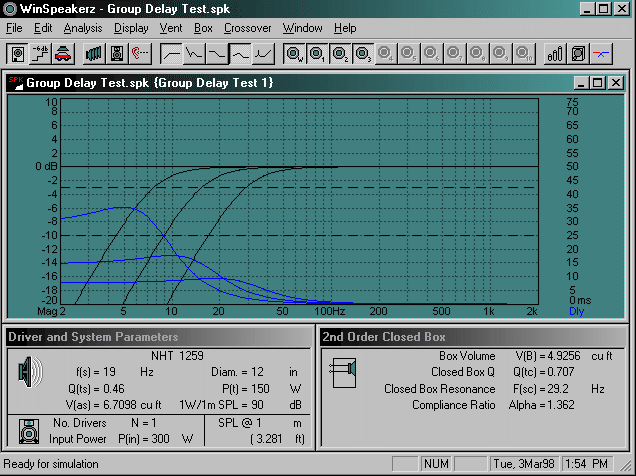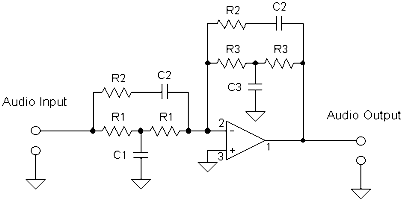Vi vet ju alla att det finns ett begrepp som på svenska kallas grupplöptid, men vilken praktisk betydelse har det inom audio - och när blir det påtagligt?
Förutom att introduceras i filter, kan man få grupplöpseffekter beroende på vilken typ av låda man använder och hur den är dimensionerad.
Underavstämda basreflexlådor och slutna lådor med lägre q-värden (under 0.6) tenderar att ha liknande grupplöptidsbeteende, så lågt att det inte har hörbar effekt.
Slutna lådor med höga q-värden (över 0.
Iallafall är det här så som jag förstått det. Men vad betyder det och på vilket sätt upplever vi det praktiskt när grupplöptiden blir stor? För mig har det praktiskt betytt att när grupplöptiden överskrider den tidsgräns (jo, man kan överföra ökad grupplöptid i just tid) där vi kan sortera ut och alltså särskilja ljud. Det håller inte ihop.
Kanske har jag förstått det fel, men att det blir en tidsaspekt på det har varit självklart för mig. Alltså oavsett hur grupplöptiden uppkommer, beroende på låda eller filter, är det just introduktionen av tidsförskjutningar som är det vässentliga. Ju längre våglängden blir, desto högre grupplöptid verkar vara acceptabelt.
(posted to Bass List)
Steve wrote:
>To repeat an earlier question that got lost, if I could hear group delay
>in a system, what would it sound like? Can you describe it?
The basic equivalent circuit model of a dynamic speaker system is that of an electrical highpass filter. Such filters have the characteristic of increasing group delay at low frequencies. Thus, in general, our speaker systems tend to delay the lows while allowing the highs to arrive without delay.
Let's consider the trivial case of EXTREME delay at low frequencies. For source material imagine that we use a recording of a single snare drum hit. We know what a snare drum normally sounds like. Now, imagine introducing a delay of 5 seconds on the lows. Play the drum recording through such a delay and you hear the high frequency "snap" of the drum followed 5 seconds later by the lower frequency "thump" components. So instead of hearing one integrated "pop" sound we instead hear a "snap" followed much later (5 sec) by the "thump". We could all easily hear the delay in this exaggerated "thought experiment".
But real speakers don't add seconds of delay. They only add milliseconds or tens of milliseconds of delay. So the real question comes down to "how much delay is just audible". If we were to gradually reduce the delay in the above experiment to zero there would come a point where the delay was no longer audible as a separate distinct sound. This would probably happen above the Hass limit of 30ms or so. As the delay is reduced further there would come a point where the "delay distorted" or "time smeared" version was indistinguishable from the original recording. This delay would represent the threshold of audibility for this delay curve and source material.
Our mission as speaker designers is to keep our group delays below the threshold of audibility. In order to do this we need to first know what group delay our speakers are imparting on the music, and second, know what degrees of delay are audible.
On the subjective side I suspect that delayed bass or "late" bass is what we experience as "slow" bass. Alternately, I suspect the subjective quality of "fast bass" is likely to be associated with those systems where the bass arrives "on time" within the minimum detectable delay threshold
************

The rightmost curve has a 3 dB corner at about 30 Hz and experiences about 8 msec of group delay at 30 Hz.
The middle curve is a simulation of a similar system (Qtc = .707 for all three cases) but with a corner frequency of 15 Hz. This system has a group delay of 15 msec at its corner frequency but has only 4 msec of delay at 30 Hz.
The third (leftmost curve) system has a corner frequency of 7.5 Hz and while it experiences a full 30 msec of delay at its corner frequency it only has about 2 msec of delay at 30 Hz.
System Corner Frequency......30hz.....15hz......7,5hz
Delay at Corner Frequency.... 8ms......15ms....30ms
Delay at 30 Hz.....................8ms......4ms.......2ms
From the table you can see that lowering the corner frequency reduces the group delay of the system at a given pass band frequency (30 Hz in this example). The less delay the better. Ideally the low frequency components of the program signal would experience NO DELAY compared to the mids and highs.
One way to experiment with very low corner frequencies in closed boxes that does not require the "brute force" of a huge enclosure is to apply a line level "Linkwitz Transform" to the system. This is a simple one op-amp stage that neutralizes the existing 2nd order high pass response and then imposes a new (lower corner frequency and new Qtc) high pass response. Think of it as surgically precise equalization. You can read the details about this circuit in Speaker Builder issue 4/1980. Here's the circuit to show you the idea:

Say your existing closed box is is characterized as: Fsc = 40 Hz and Qtc = .95.
You can use the above circuit to change the response to Fsc = 20 Hz with Qtc = .5
...or to any other Fsc and Qtc.
I have created an Excel spreadsheet that calculates the values for the above "Linkwitz Transform" circuit. You can download it here: Linkwitz Transform Spreadsheet: http://www.trueaudio.com/downloads/linkxfrm.xls
Also, see my new Tech Topic: Designing a Linkwitz Transform Circuit:
http://www.trueaudio.com/st_lkxfm.htm
Den engelska texten är skriven av Johm Murpy som inlägg på en epostlista som hette basslist, någon gång 1998-1999.
Även om man kanske adresserar grupplöptiden med ovan filter kommer man väl behöva trycka på med mer effekt, vilket i sig kan leda till effektkompression ?
Det är alltså bättre att konstruera sin låda efter de optimala förutsättningar det ger, eller välja ett annat element för de förutsättningar man kan erbjuda.
Så,
a) Hur kommer vi uppleva en ökad grupplöptid?
Stämmer inte informationen i texten ovan? För mig känns det logiskt..
b) Hur hanterar vi fenomenet bäst i våra konstruktioner?
Jag ser lådkonstruktioner med relativt låga q-värden och där man håller grupplöptiden låg som naturliga, dvs grupplöptidstänket måste vara en del av konstruktionen! Nu pratar vi grupplöptid som har med lågfrekvennsområdet att göra och inte det som uppkommer eller nyttjas i filterdesign.
Tänker jag rätt/fel?
Kommentarer mottages tacksamt, gärna välutvecklade och sakliga. Det är kul att lära sig nya saker, och ännu roligare att bli uppmärksammad och fått förklarat för sig om man har tänkt fel.
